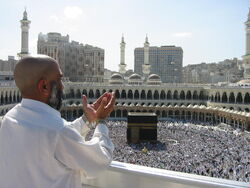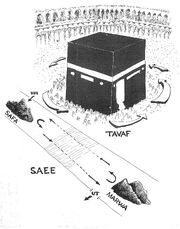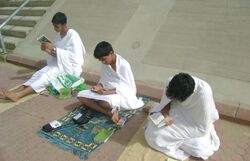
A supplicating pilgrim at Masjid al-Haram, the mosque which was built around the Kaaba (the building at center). In this image of the Hajj from 2003, thousands of pilgrims are walking around the Kaaba in a counter-clockwise direction (Tawaf).
The Hajj ( Ḥaǧǧ) is a pilgrimage to Mecca (Makkah). It is the largest annual pilgrimage in the world, and is the fifth pillar of Islam, an obligation that must be carried out at least once in their lifetime by every able-bodied Muslim who can afford to do so. The Hajj is a demonstration of the solidarity of the Muslim people, and their submission to Allah. The pilgrimage occurs from the 8th to 12th day of Dhu al-Hijjah, the 12th month of the Islam. Because the Islamic calendar is a lunar calendar, eleven days shorter than the Gregorian calendar used in the Western world, the Gregorian date of the Hajj changes from year to year. In 2007, the Hajj was from December 17–21; in 2008 from December 6–10, and in 2009 will be November 25–29.
The Hajj is associated with the life of prophet Muhammad (s.a.w) from the 7th century, but the ritual of pilgrimage to Mecca is considered by Muslims to stretch back thousands of years to the time of prophet Ibrahim (Abraham). Pilgrims join processions of hundreds of thousands of people, who simultaneously converge on Mecca for the week of the Hajj, and perform a series of rituals: Each person walks counter-clockwise seven times about the Kaaba, the cube-shaped building which acts as the Muslim direction of prayer; kisses the Black Stone in the corner of the Kaaba; runs back and forth between the hills of Al-Safa and Al-Marwah; drinks from the Zamzam Well; goes to the plains of Mount Arafat to stand in vigil; and throws stones in a ritual Stoning of the Devil. The pilgrims then shave their heads, perform a ritual of animal sacrifice, and celebrate the three day global festival of Eid al-Adha.
As of 2008, about three million pilgrims participate in this annual pilgrimage. Crowd-control techniques have become critical, and because of the large numbers of people, many of the rituals have become more stylized. It is not necessary to kiss the Black Stone, but merely to point at it on each circuit around the Kaaba. Throwing pebbles was done at large pillars, which for safety reasons in 2004 were changed to long walls with catch basins below to catch the stones. The slaughter of an animal can be done either personally, or by appointing someone else to do it, and so forth. Muslim historians refer to the time before prophet Muhammad (s.a.w) as Al-Jahiliyah, the "Days of Ignorance", during which the Kaaba contained hundreds of idols – totems of each of the tribes of the Arabian peninsula, with idols of pagan gods such as Hubal, Al-Lat, Uzza and Manat, and also some representing Jesus, and Mary.
Prophet Muhammad (s.a.w) was known to regularly perform the Umrah, even before he began receiving revelations. Historically, Muslims would gather at various meeting points in other great cities, and then proceed en masse towards Mecca, in groups that could comprise tens of thousands of pilgrims. Two of the most famous meeting points were in Cairo and Damascus. In Cairo, the Sultan would stand atop a platform of the famous gate Bab Zuwayla, to officially watch the beginning of the annual pilgrimage.
In 632 AD, when prophet Muhammad (s.a.w) led his followers from Medina to Mecca, it was the first Hajj to be performed by Muslims alone, and the only Hajj ever performed by Muhammad. He cleansed the Kaaba, removed all of the idols, and re-ordained the building as the house of God. It was from this point that the Hajj became one of the Five Pillars of Islam.
Preparations[]
Pilgrims generally travel to Hajj in groups, as an expression of unity. Some airlines have special packages for Muslims going to Mecca. Ships also take pilgrims to Mecca so they can perform Hajj.
During the Hajj, male pilgrims are required to dress only in the Ihram, a garment consisting of two sheets of white unhemmed cloth, with the top draped over the torso and the bottom secured by a white sash; plus a pair of sandals. Women are simply required to maintain their hijab - normal modest dress, which does not cover the hands or face.
Umrah[]

Direction of the Tawaf around the Kaaba
On the first day of the Hajj (the 8th day of the 12th month in other words, Dhu al-Hijjah), the pilgrims perform their first Tawaf, which involves all of the pilgrims entering The Sacred Mosque (Masjid Al Haram) and walking seven times counter-clockwise around the Kaaba, kissing the Black Stone (Hajr Al Aswad) on each circuit. If kissing the stone is not possible due to the crowds, they may simply point towards the Stone on each circuit. Each complete circuit constitutes a "Shout" with 7 circuits constituting a complete tawaf. The place where pilgrims walk is known as "Mutaaf". Only the first three Shouts are compulsory, but invariably almost all perform it seven times.
Eating is not permitted and the tawaf is normally performed all at once, the only exception being the drinking of water. Men are encouraged to perform the first three circuits at a hurried pace, followed by four times, more closely, at a leisurely pace.
After the completion of Tawaf, all the pilgrims have to offer two Rakaat prayers at the Place of Abraham (Muqaam E Ibrahim), a site inside the mosque that is near the Kaaba. However, again due to large crowds during the days of Hajj, they may instead pray anywhere in the mosque.
Although the circuits around the Kaaba are traditionally done on the groundlevel, Tawaf is now also performed on the first floor and roof of the mosque.
After Tawaf on the same day, the pilgrims perform sa`i, running or walking seven times between the hills of Al-Safa and Al-Marwah. This is a re-enactment of the frantic search for water for her son Ismael by Abraham's wife Hagar. As she searched, the Zamzam Well was revealed to her by an angel, who hit the ground with his heel (or brushed the ground with the tip of his wing), upon which the water of the Zamzam started gushing from the ground. The back and forth circuit of the pilgrims used to be in the open air, but is now entirely enclosed by the Masjid al-Haram mosque, and can be accessed via air-conditioned tunnels. Pilgrims are advised to walk the circuit, though two green pillars mark a short section of the path where they are allowed to run. There is also an internal "express lane" for the disabled. The safety procedures are in place because previous incidents in this ritual have resulted in stampedes which caused the deaths of hundreds of people.
As part of this ritual the pilgrims also drink water from the Zamzam Well, which is made available in coolers throughout the Mosque. After the visit to the mosque on this day of the Hajj, the pilgrims then return to their tents.
Arafat[]

Pilgrims on Plains of Arafat on the day of Hajj
The next morning, on the ninth of Dhu al-Hijjah, the pilgrims leave their tents at Mina for Mount Arafat, where they stand in contemplative vigil, near a hill from which Muhammad gave his last sermon. This is considered the highlight of the Hajj. Pilgrims must spend the afternoon within a defined area on the plain of Arafat until after sunset. No specific rituals or prayers are required during the stay at Arafat, although many pilgrims spend time praying, and thinking about the course of their lives. If a pilgrim does not spend the afternoon on Arafat, then their pilgrimage is considered invalid. The stoning consists of throwing seven pebbles. Specifically, the report states that the Hajj "increases belief in equality and harmony among ethnic groups and Islamic sects and leads to more favorable attitudes toward women, including greater acceptance of female education and employment" and that "Hajjis (those who have performed the Hajj) show increased belief in peace, and in equality and harmony among adherents of different religions"
Number of foreign pilgrims by year[]
According to the Royal Embassy of Saudi Arabia, the following number of foreign pilgrims arrived in Saudia Arabia each year, to perform the Hajj:
- 1996 - 1,080,465
- 1997 - 1,168,591
- 1998 - 1,718,186
- 2001 - 1,804,800
- 2006 - 1,557,447
- 2008 - 1,729,841
See also[]
- List of Islamic terms in Arabic
- List of largest religious gatherings
- Tourism in Saudi Arabia
- Haj subsidy
Notes[]
References[]
External links[]
- www.PerformHajj.com A Muslim's Pilgrimage to Mecca – Official Website.
- Ministry of Hajj Website
- Time Magazine Photo Essay: The Hajj Goes High Tech
- Hajj - Pilgrimage to Makkah - A Video Guided Tour - Part 1/2
- Hajj - Pilgrimage to Makkah - A Guided Video Tour - Part 2/2
